
Bangladesh?s Worst Industrial Accident: Scenes From a Terrifying Tragedy

Musings by Shahidul Alam


 |
|
?ABIR ABDULLAH
Workers line up unclaimed bodies of victims of on accidental fire in a mass funeral at a grave at Jurain in Dhaka, Bangladesh.
|
Abir Abdullah of Bangladesh has won the $15,000 professional award in the Alexia Foundation grant competition, organizers announced this morning. Continue reading “Abir Abdullah, Sara Naomi Lewkowicz Win Alexia Foundation Grants”
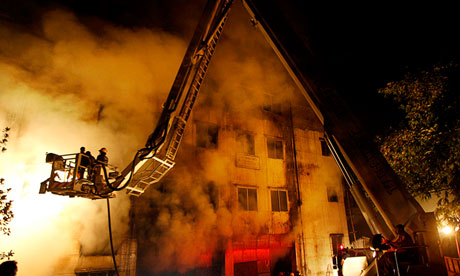 Firefighters battle the blaze at the Tazreen Fashions plant in Dhaka, Bangladesh. Photograph: Hasan Raza/AP
Firefighters battle the blaze at the Tazreen Fashions plant in Dhaka, Bangladesh. Photograph: Hasan Raza/APSunday 25 November 2012
Photos by Abir Abdullah/EPA
NEW DELHI ? Rescuers were searching for survivors on Tuesday after a ferry carrying as many as 200 passengers capsized in Bangladesh, killing at least 24 people with many more feared dead.

Continue reading “While Awami League Fiddles”
Drik mourns the death of two dear friends, the injuries of three others and the numerous deaths of their colleagues and the thousands of uncounted others who regularly die as a result of negligence, corruption and the wanton irresponsibility of those who are in charge of keeping our roads safe.
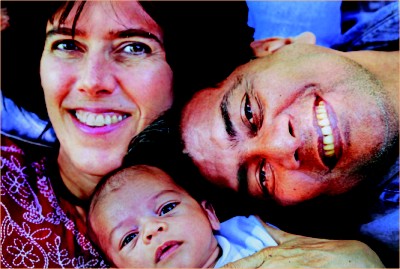
Tareque Masud, one of the finest film makers this nation has produced. Mishuk Munier, a talented cameraperson and a media professional who had both the dreams and the ability to change the way reporting was done, died a brutal death as they were returning to Dhaka having chosen the location for their next film.
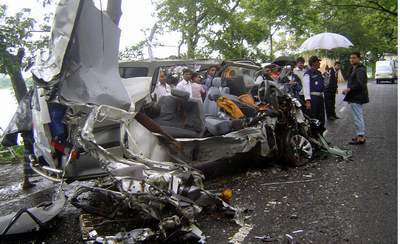
Catherine,?Tareque’s equally talented wife, the producer of the Oscar nominated film Matir Moina, artist Dhali Al Mamoon, who had given the inaugural Golam Kasem Daddy lecture on Drik’s 20th anniversary, and his painter wife Dilara Begum Jolly are in hospital recovering from multiple injuries. Dhali’s condition is critical.
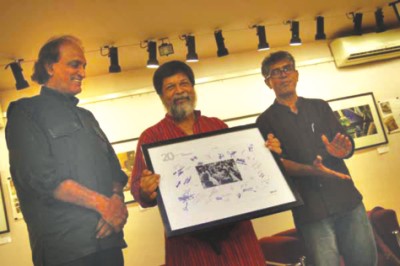
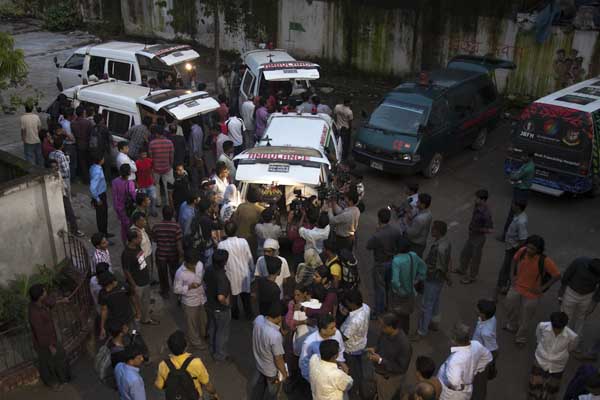

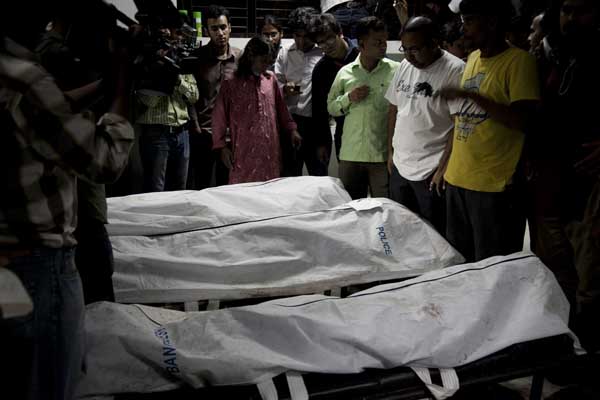
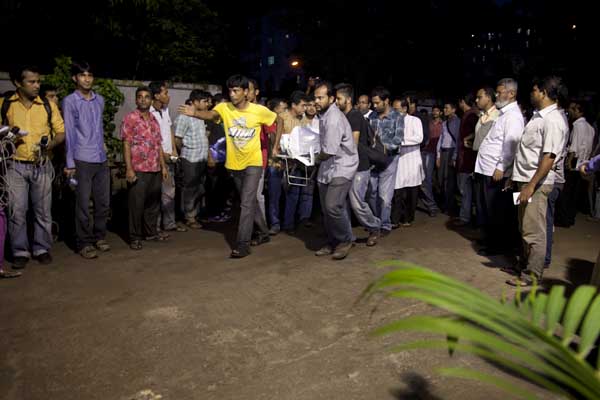
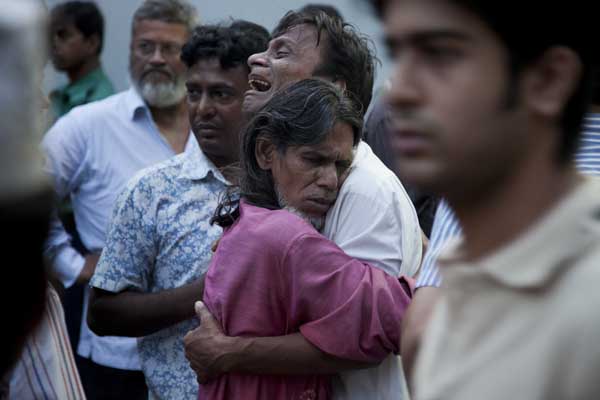
Obituary on Guardian UK
A fire broke out on 03 june 2010 night at about 9pm after the electrical transformer at Nawab Katra in Nimtali in Dhaka City burst into flames that raced through several apartment complexes, feeding on flammable chemicals and plastic goods in a string of small shops lining the street beneath, fire officials said. Dearh toll rose to 119 while many are struggling in the hospitals for life.
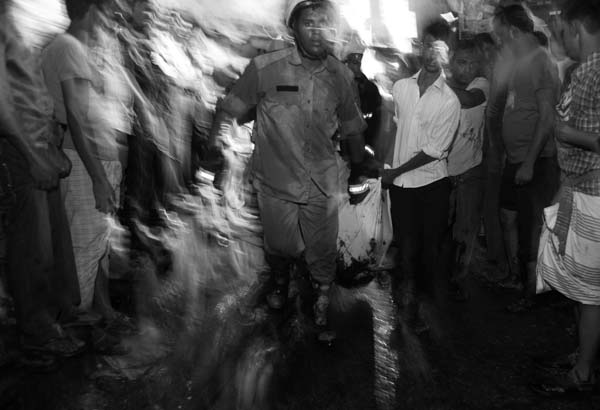
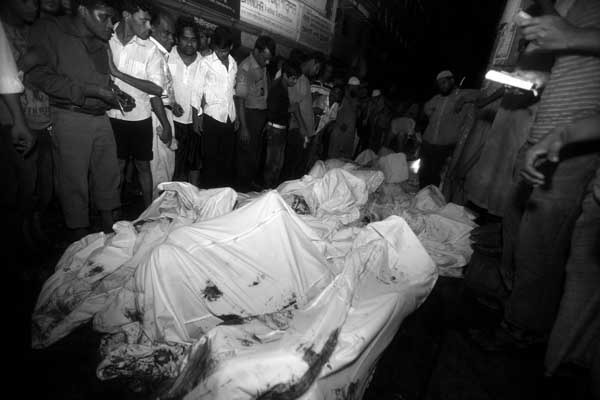
Fire is an ever present death threat for the entire community of Dhaka city. From homes and workplaces to shopping malls and public spaces, a lack of building codes and fire protection have created a situation where residents are living in a continual death trap. And due to lack of training and proper rescue equipment for the fire service authority, fire accidents are responsible for the destruction of assets and homes as well as lives. The widespread lack of equipment and protection means fire deaths affect nearly everyone, from working class to middle class, and even the elites.
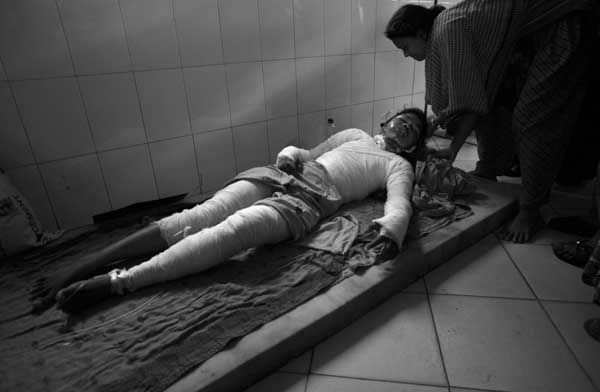
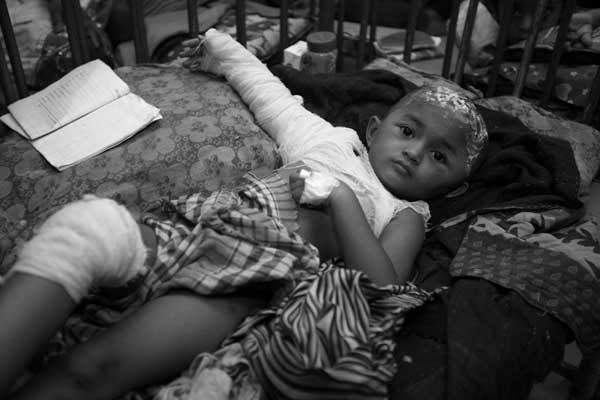
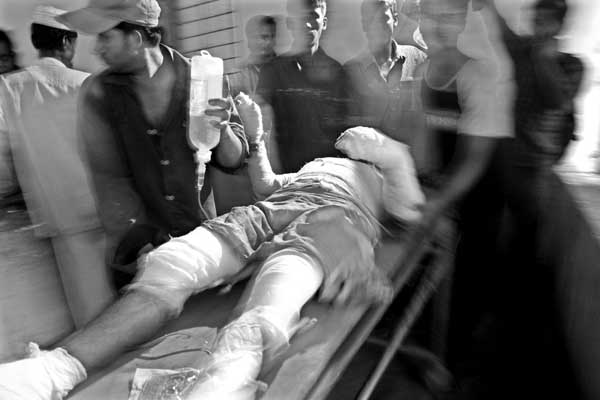
I have been documenting the important issue of fire risks faced by residents of Dhaka for the last couple of years. Through my work, I have seen civilians risking their lives to save others in rescue operations. Firefighters with lack of training and proper rescue equipment are also part of the rescue operation, bringing injured and panicked victims of fire to safety. I believe my photo essay will raise awareness, and hope that it will act as a catalyst for the authorities to take prompt action to save the life and property of an entire community. I hope it will help the policy makers and administrations to consider how Dhaka city has become the ?second worst? livable city in the world. I want to show how reversing the trend of inefficiency and neglect by the authorities can help bring an end to the needless loss of many lives in the peaceful, beautiful city of Dhaka.
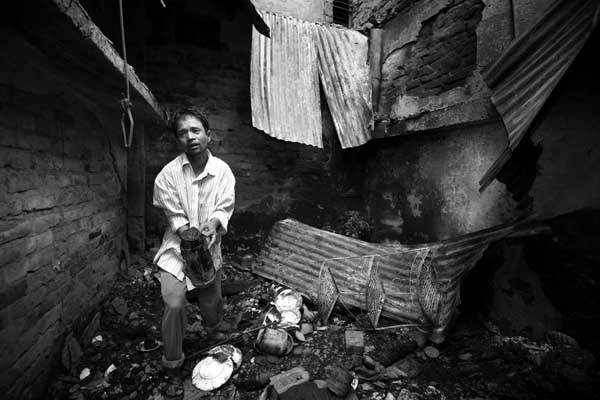
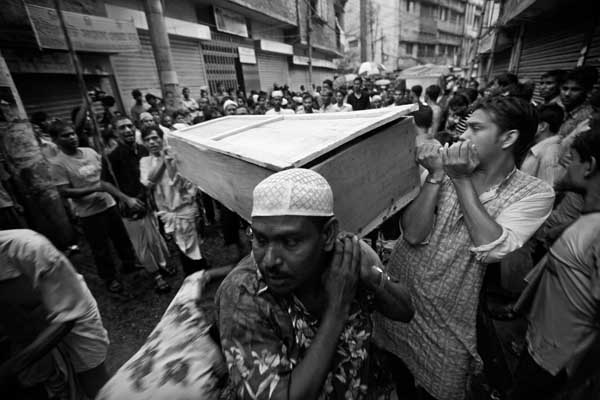
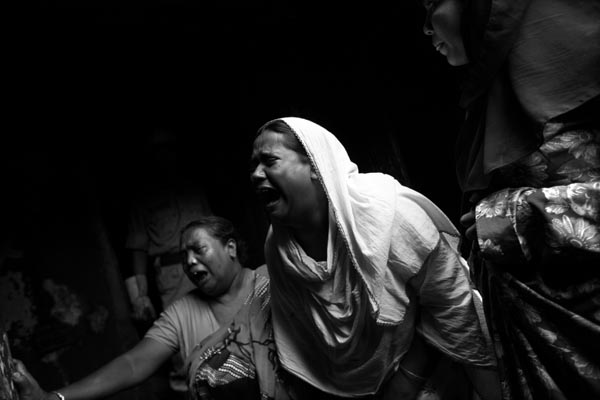
—
Abir Abdullah
Photographer
european pressphoto agency b.v. (epa)
Bangladesh Bureau
Mobile: 8801715105546
More pictures at:
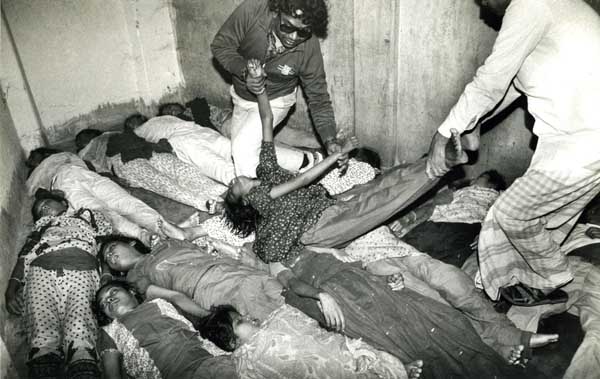
Triangle Shirtwaist Factory Fire, New York City, March 25, 1911
Whoever saw the hellish fire at 33 Washington Place,
A terrible tragedy, something quite new,
Can never forget it, And everyone knows many lives were lost.
They were incinerated, In a factory 10 stories high.
There were horrible screams from the onlookers,
Those who were burned alive
And those who choked in the smoke.
(Yehuda Horvitz wrote and sung this song to the tune of a Jewish prayer to commemorate?the deaths of Jewish women in the Triangle Fire)
In many ways, the Triangle Shirtwaist Company was just another sweatshop factory?in the heart of Manhattan. It was located on the top three floors of the ten-story Asch Building just at the end of Washington Square. All that characterizes a sweatshop ? low wages, excessively long hours, and unsanitary and dangerous working conditions ? was part of its factory policy. Most of the several hundred Triangle employees were young women.? Many among them were recently-arrived Italian or Jewish immigrants.
On March 25, 1911, as the hours of the clock approached the closing time, a fire broke out on the top floors of the Asch Building. Flames leapt from discarded rags between the first and second rows of cutting tables.? The fire spread everywhere, as several men continued to fling water at the fire.? In the thickening smoke, a shipping clerk dragged a hose in the stairwell into the rapidly heating room, but nothing came out.? Terrified and screaming girls tried to climb down the narrow fire escape.? Some girls trapped on the ninth floor jumped through the window (Leon Stein, Out of the Sweat Shop, 1977). By the time the fire was over, 146 women garment worker had died. The next two days were marked with the horror and grief of families and comrades desperately trying to identify their dear ones from the bodies burned to bare bones.
In 1909, when women garment workers started to organize and called for a strike demanding better pay, safe working environment, Triangle Shirtwaist was one of the factories which agreed to only a partial settlement. One of the demands that was not met in this settlement was the demand for adequate fire escapes (Meredith Tax, The Uprising Thirty Thousands, 1994). These deaths, horrifyingly cruel, agitated the members of International Ladies Garment Workers Union (ILGWU). Many thousands joined the funeral procession, they mourned the lives lost, and demanded the safety for workers.
Two weeks after the fire, a grand jury indicted Triangle Shirtwaist owners Isaac Harris and Max Blanck on charges of manslaughter. Three years after the fire, on March 11, 1914, twenty-three individual civil suits against the owner of the Asch Building were settled.? The average recovery was $75 per life lost. Calls for justice continued to grow,?thirty-six new laws reforming the state labor code were enacted between 1911 and 1914, those who survived the fire were left to live, and relive, those agonizing moments.
Garib and Garib Sweater Factory, Gazipur, February 25, 2010
21 killed at Garib and Garib Factory, Gazipur, 2010
62 killed at KTS Garments, Chittagong, 2006
23 killed at Shan Knitting, Narayanganj, 2005
23 killed at Chowdhury Knitwear, Narsingdi, 2004
23 killed at Macro Sweater, Dhaka, 2000
12 killed at Globe Knitting, Dhaka, 2000
24 killed at Shanghai Apparels, Dhaka, 1997
20 killed at Jahanara Fashion, Narayanganj, 1997
22 killed at Lusaka Garments, Dhaka, 1996
32 killed at Saraka Garments, Dhaka, 1990
(Source: The Daily Star, March 1, 2010)
It was a little after 9 o?clock at night, workers were finishing their shift. Some were still working, Abdul Mannan of the Garib and Garib factory?s sampling section was among them. He was working on the second floor when he first saw the flame and breathed smoke. It was coming from the first floor. A short circuit had occurred near a large stock of flammable acrylic sweaters, which produced thick and extremely toxic smoke and quickly transformed the factory into a ?gas chamber? (Bdnews24.com, Feb26, 2010). Zarina, Farida, Majeda, Sahara, Majida, Rahima, Shantana, Momtaz, Rasheda, Shahinur, Rawshan, Jahanar, Rina and Sufia were on the sixth floor as the monstrous fire swallowed the building.? The main power was immediately turned off. In the pitch dark, workers, both men and women, ran up stairs to escape, but blazing fires and toxic smoke followed them.
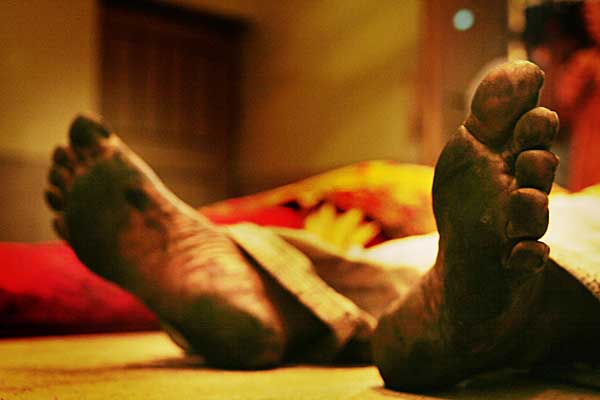
Within half an hour, ambulances and firefighters had circled the building, they started their rescue mission but came across dead bodies only: Kashem, Badal, Alamgir, Mainul and Pradeep, bodies which lay haphazardly in the stairway, there were many others. The events that followed were rather routine. After hours of effort, the fire-fighters tamed the unruly fire.? The Fire Brigade authorities, BGMEA and the government formed three different probe committees to investigate the cause of fire (Daily Star, Feb 27, 2010). In a ?sympathetic? gesture, the authority bore the cost of the burials and kept the factory closed for four days to mourn the deceased workers.? The BGMEA ?expressed sorrow at the death of the workers and announced Tk 2 lakh as compensation for each worker? (New Age, Feb 26, 2010). Labor organizations and left-alliances protested, demanding better compensation, and immediate punishment of those responsible.? They continue to protest, to hold meetings in Muktangon, in Shahid Minar, in Gazipur too, protests which barely manage to prevent us from forgetting about them. Perhaps through taming the fire, the fire-fighters had also tamed the sparks of our anger, anger at the deaths, anger at exploitative and unjust practices in the garments industry.
Collectively Resisting Our Amnesia
The hundred years which separates these two tragedies in the history of the garments industry, incidents that are strikingly similar, also coincides with the international women?s movement which has turned a hundred year’s old. By placing these two stories side by side, I don?t intend to undermine the struggles and achievements of our movement, to argue that ?nothing has changed.? My interest lies in the differences in our response to the two tragedies.
People gathered in thousands to cordon the dead bodies of Triangle factory workers, to hold the hands of hysterically grieving relatives and friends. The ILGWU proposed an official day of mourning. The grief-stricken city gathered in churches, synagogues, and finally, in the streets. In 1911, the funeral procession turned into an ocean of grief as countless numbers of people joined in, while the dead bodies of Zarina, Majeda and Farida were sent in separate ambulances to their village, and the only people who joined in that final journey, besides their family members, were the police. We do not join in their funeral procession in the thousands, we do not take over the street to mourn the lives of these women who had slaved their youth away for the much celebrated, and steady increase in the nation’s GDP. As I read Yehuda Horvitz songs written to commemorate the lives of the women killed in the Triangle fire, I look for songs sung celebrating the lives lost here. What I find is a statistical rhyme, an incomprehensive list of the numbers of workers killed in garments factory fires in the last decade. The thought of garments factories being ?gas-chambers? horrifies us? as long as the news remains fresh, and soon enough, we manage to find ways of returning to the national narrative, working in the garments sector is a stepping stone to women?s empowerment. Images of blazing fires rapidly disappear, stories of Rasheda, Shahinur, Rawshan choking to death are conveniently forgotten. In 1911, many women in the funeral procession in New York city had carried placards which said ?we mourn our loss; we demand real progress in workers protection.? In 2010, we do not mourn our loss. We read of our loss in the newspapers.
There has been much talk of corporate greed and sweatshops, many editorials have been written protesting the criminal indifference of factory owners. Locally and globally, every year thousands of pages are written analyzing the sweatshop economy and the feminization of the global labor force. Perhaps, it’s time to analyze our deadly indifference. On international women?s day, a true tribute to Rahima, Shantana, Momtaz and many other sisters whose names will soon be lost in the statistical crowd, can be offered by resisting our own collective amnesia.
Saydia Gulrukh is a PhD student at the University of North Carolina – Chapel Hill, USA
and a faculty member of Pathshala, The South Asian Media Academy
Published in New Age, 8 March 2010
Online Norwegian version in Dagbladet
shipbreaking-magazinet1?PDF in Norwegian Magasinet
dagbladet-nyhet?PDF in Norwegian Nyhet
“You wouldn’t have the time” he’d said. It was a polite conversation. Salahuddin, the cousin of Jahangir Alam, had rung me to thank me for helping him get an ambulance at the Apollo Hospital in the elite Bashundhara Complex in Bangladesh’s capital Dhaka, 250 kilometres from the port city Chittagong. Despite the hospital’s motto of “Bringing healthcare of international standard within the reach of every individual,” it was understood that all patients were not equal. Jahangir and his family had been waiting for over five hours. The hospital was for rich people and Jahangir, a worker at Ziri Subeder Shipbreaking Yard was undeniably poor. Even though the money had been paid, Jahangir, on his deathbed was not going to get the same treatment the other VIP patients at Apollo were given. Eventually the presence of a pesky journalist taking pictures had enough nuisance value for the hospital to dredge up an ambulance. Jahangir would arrive at a cheaper, less equipped hospital in Chittagong, in the early hours of the morning. Knowing I was interested in the plight of the workers, Salahuddin had rung to tell me there had been another accident. A worker was in hospital and they were going to amputate his leg. He felt my presence might save the man’s leg. I was due to go to London the following day, for a brainstorming meeting with Amnesty International. Going to and from Chittagong that day would have been difficult. I had things to do before leaving. Salahuddin was right. Even though I knew that my presence might perhaps have made a difference to a man’s life. I didn’t have the time. We never have the time. Not for some people.
The working conditions at the shipbreaking yards of Chittagong are well known. It is the usual story. In order to get the ships, the Bangladeshi shipbreakers pay the best rates to the ship-owners. To retain their profits, they pay the workers the lowest rates in the world, and provide virtually no safety. Workers die and suffer injuries on a regular basis. Some receive modest compensation, others don’t. According to workers, many deaths are simply not registered with the bodies being ‘disappeared’ by the owners.
I had wanted to do a story on the shipbreaking yards for some time. When Halldor Hustadnes of the Norwegian newspaper Dagbladet approached me I was immediately interested. I rescheduled a short assignment in Manila so that we could work together for the entire period. A loophole in the Basle Convention was allowing ship-owners to continue dumping ships with toxic waste with abandon in majority world countries that had little regulation.
The new International Maritime Organisation, convention was about to be ratified, but environmentalists felt it would not result in better conditions for workers. Norwegian ship-owners, who benefitted the most from loopholes in the convention (like the ships not being declared waste, and therefore not falling under waste jurisdiction), were a powerful lobby. Even Lloyds the insurers, who register and control the world’s shipping, felt the new convention would not have an effect.
We were hoping our story, timed to appear before the ratification of the convention, would bring attention to the plight of the workers. Getting access to the yard was going to be the main stumbling block. My student Sourav Das, put me in touch with Wahid Adnan. Adnan had good links with Rahman yard. We had been told that the Norwegian ship UMA was berthed at Rahmania yard. The slightly different name might just have been due to a mistake in communication. There was a ship UMA near Rahman yard. This was a breakthrough. Adnan managed to get me in, but though it was the right ship, it was the wrong yard. UMA was going to be broken at Royal, the yard next to Rahman, where we had no access.

So we started with the access we had, and worked our way across the porous beach. It was a Friday. The weekend in Bangladesh. We utilised the absence of the manager to bluff our way into the ship. The abundance of asbestos, the open chemical store, the sacks of Potassium Hydroxide pellets and other toxic chemicals left unprotected, were all fairly visible. One of the workers talked of the films they had been shown about how asbestos was toxic, and had to be buried under concrete and that workers needed to wear protective clothing. “But that was just a film” he said.

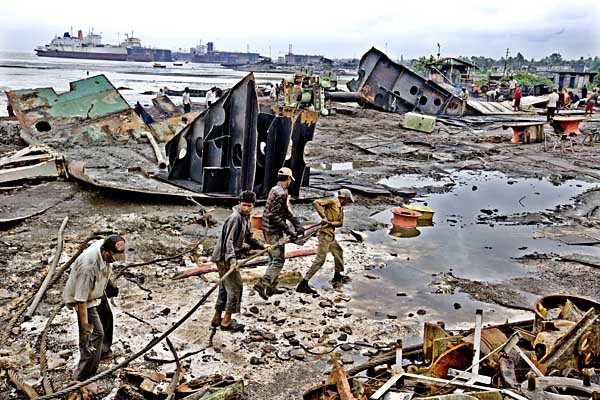
Shujon was the smallest of the workers. With marigolds dangling from his ears, he insisted on being photographed. He behaved like a child, though we found out he was older than he looked. Only wealthy Bangladeshis have birth records. And with most children being malnourished, looks can be deceptive. Shujon was a helper. Hirolal, the cutter he was helping, didn’t look much older than him. They were cousins. Shielding his eyes from the intense heat with his hands, Hirolal, broke down larger pieces of metal into more manageable shapes. Shujon cleared the debris, oblivious to the sparks that flew around him. Both boys wanted to find work overseas. Singapore was their dream destination. I didn’t tell them that Bangladeshi workers in Singapore, often found themselves in similar bonded labour. At least Shujon and Hirolal had a dream. The contractor came over and started beating up Shujon. He needed to get on with his work. We were getting him into trouble and kept our distance.
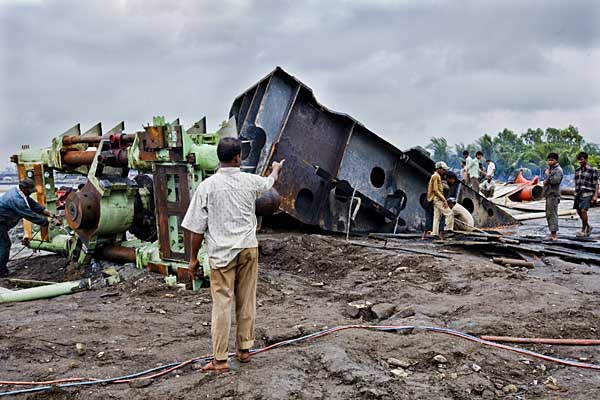
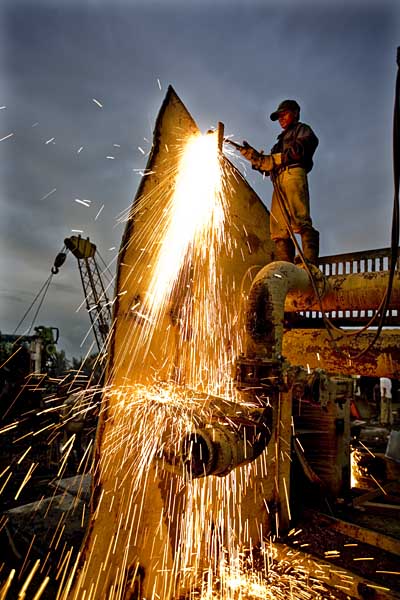


Early the following morning I saw Rubel, bailing out the water from a lifeboat. Rubel was 14 and had been a ferry ‘man’ since he was 11. His mother didn’t really want him to be doing risky work, but they needed the money. We left before sunrise, before the manager arrived. Rubel was well into his day’s work.
That night when the manager had left, we went back into the yard and slept with the workers. We were guests and had the luxury of having a metal sheet to ourselves for a bed. They sung for us that night. Not the pop songs that we heard on television, or the Tagore songs that the wealthy elite took as a sign of culture. They were haunting songs of longing and parting. One was a song about visas:
With a two day visa
To this false world
Why did Alla send me
Why send me here
With the pain of seeking comfort
He sent me on my own
What game did he play
What game does he play

With an empty water bottle and a wooden box as a drum, we sang into the night. Their raw voices blending with the steady rain on the tin roof. “We are poor folk. There’s work tomorrow. We need to sleep.” The foreman said abruptly. We knew the songs had been sung for the entertainment of the guests, at the cost of much needed rest. I walked out into the rain. The tide was coming in. UMA was glistening in the yard searchlight. The guards in their yellow raincoats stood out in the darkness.
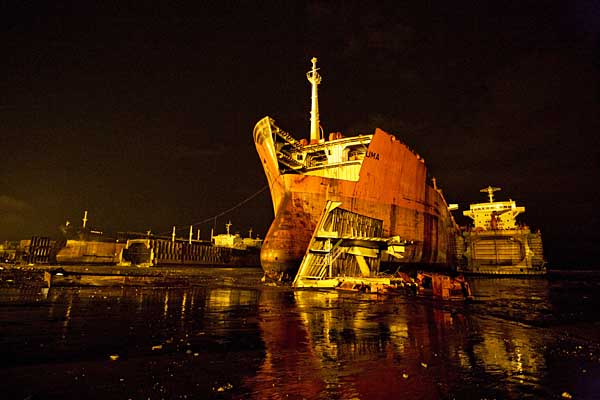

Captain Inam was a boisterous jovial man. He was the most experienced beach captain, and the de-facto spokesperson for the shipyard owners. He was much in demand. When we wanted to speak to the owners, they insisted that the good captain be around. The owners spoke little, leaving it up to the articulate seaman to fend our questions. They invited us over to Bonanza, a posh restaurant in downtown Chittagong. One of the many businesses owned by Mr. Amin, in whose yard two other Norwegian ships, the Gold Berge and New Berge were also being stripped. Captain Inam explained how the ship-owners who made the bulk of the profit took no responsibility for the situation of the workers. How they should allocate a percentage of their profits to building a modern shipyard in Chittagong. How these environmentalists were in collusion with the Northern ship-owners and working towards increasing their profits. Of how the shipyard owners really felt for the workers. Of how they provided helmets, and gloves and shoes to all workers, but that workers didn’t want to wear them. None of this matched with what the workers had to say. “A pair of shoes cost us 500 Taka” they said. That was four days’ wages for the average worker. Odfjell the Norwegian owner of UMA had made 7.5 million dollars from the sale of the dying ship.
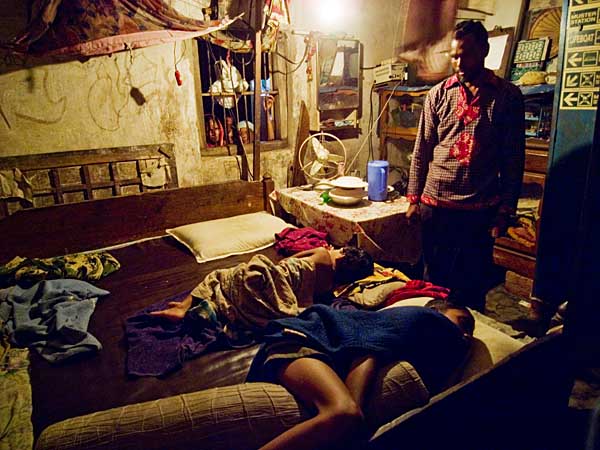
The foreman cutter talked of how he had escaped death but the person next to him had died due to poisoned gas in the hull of a ship. He took us to his one room house where the parents and the two children shared a bed that almost occupied the entire room. He talked of the four times they had tried to set up a union. Each time the local goons were used to beat them into submission. The main organisers were tortured and lost their jobs. Captain Inam, has a different version. “There are no restrictions to forming unions.” He says. “The workers are simple people and don’t think in those terms.”

The number of injuries have gone down enormously says the captain. Now there are hardly one or two a year. They take us to the hospital they are building, to reduce medical fees paid to external hospitals. We never went into the logic of requiring to build a hospital to reduce costs if only one or two deaths and a few injuries were taking place all year.
One of the workers Saiful takes us to a nearby village. Walking a few hundred metres, we come across several families of injured workers. A few say they have received modest compensation. Some say they’ve received nothing. Even though these injuries were from a few years ago, the frequency of injuries has little in common with the captain’s figures.
Shahin, an NGO worker who has been campaigning for the rights of shipyard workers, rings us to tell us of an accident that has just taken place. We rush over to Chittagong Medical Hospital (CMH). As all other public hospitals in Bangladesh, CMH is overrun. The three workers were carried up the five flights of stairs and lay on the hospital floor. There were no spare beds. Jahangir was the most badly injured. His head was bleeding, and he couldn’t move. He was barely conscious. The other two workers had broken limbs but would survive. There were no stretchers and Jahangir’s family and friends, took him across to a less busy part of the hospital floor, carrying him on a stretched sheet.

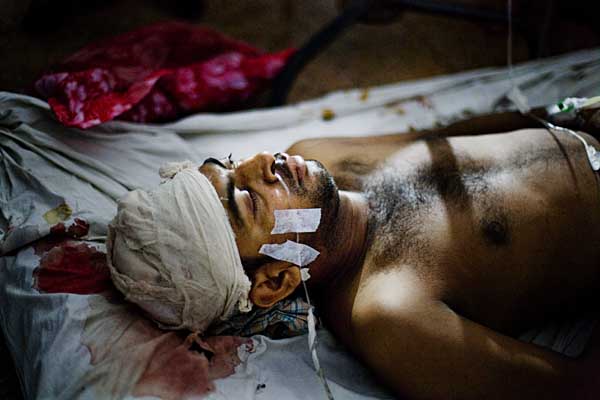
We contact Al Hajj Lokman Hakim, the owner of Ziri Subedar Yard. Mr. Hakim is angry. “They have accidents because of their own stupidity. Sometimes they have minor injuries, and we have to pay for it. If these foreigners care so much about our workers why don’t they build a new dock for us?” Cursing everyone in sight as we go down the lift of his highrise building, the Lokman Tower, Mr. Hakim drives off in his shiny car. A 5.5 million Taka car according to our driver.
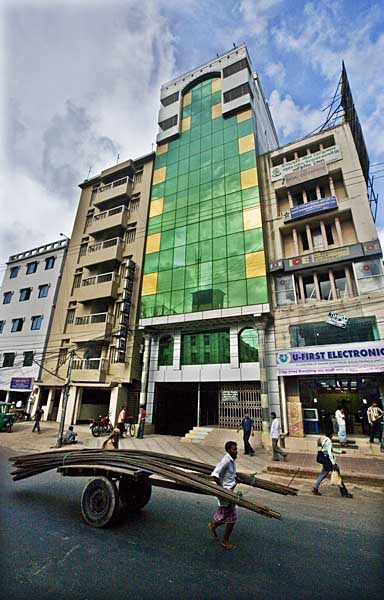
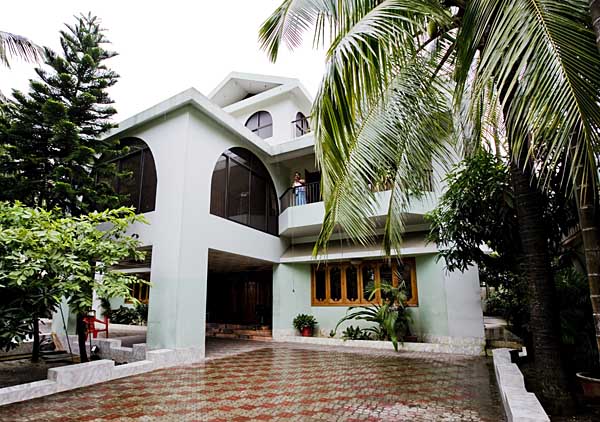
The news was more than Jahangir’s mother Nurjahan could take. Her eldest son had an accident a year ago. Two months ago her husband had died. Two weeks later, Alamgir, Jahangir’s younger brother had been injured while working in a different yard. The yard owner had paid for Alamgir’s treatment, but there was no knowing if he would ever be able to work again, or how long the owner would keep paying for the treatment. Jahangir had been the only earning member of the family. As it was, the family depended upon the generosity of the neighbours for their survival. Jahangir’s injury had left the family in tatters. “It is poverty that has driven my sons to this life,” says Nurjahan. “If my Jahangir returns, I will never send him to the yard again.”
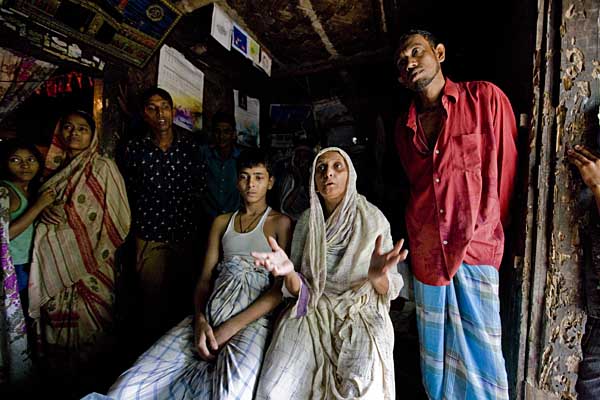
Jahangir never returned. On the night of the 6th September, Jahangir had spoken. He seemed to be on the verge of recovery. He would never walk again, but at least he would live. The following morning Shahjahan heard he had died. Shahjahan knew that the company had been concerned about the rising medical bills, and wondered if Jahangir’s death had been necessary to keep the bills down. One thing was certain. His two day visa had expired.
The ship owners in Norway, will never know he lived.
![]()
![]()
Recovering Memory. Recovering Dignity
It was 25th March, night. A Pakistani officer accompanied by soldiers entered their Dhaka University flat, dragged out Meghna’s father and and shot him. Jyotirmoy Guhathakurta was a well-known academic. He bled to death slowly, five days later. As he lay dying in Dhaka Medical College Hospital with a bullet wound in his neck, surrounded by doctors too scared to treat him, he repeatedly told Bashanti, his wife, you must write. Write what? History, he replied. But I don’t know how to write history. Well, write literature then.
 Jyotirmay Guhathakurta and Basanti Guhathakurta with seven year old daughter, Meghna and nephew Kanti in Gandaria, Dhaka, 1966. Bangladesh. ? Bazle Mawla
Jyotirmay Guhathakurta and Basanti Guhathakurta with seven year old daughter, Meghna and nephew Kanti in Gandaria, Dhaka, 1966. Bangladesh. ? Bazle Mawla
I met Meghna in 1973, the year we started college. Later we went to Dhaka University together. As we became the closest of friends, I learnt that she would lie in bed each night and recollect the horror of that night in 1971. I would tell myself, I have to remember each incident, what happened, what followed. I must not let myself forget. Many years later, I remember asking her, “Megh, do you still do that? Re-collect each scene, each incident…?” “Yes, each night, after turning out the lights, I lie in bed and remember what happened, as it happened,” was her reply.
It is important to recover memories. To tell oneself that the world was not born this moment, to remind ourselves that we have long histories. Or else, says Uruguyan novelist Eduardo Galeano, we will become like the peoples of Chicago who do not know of the Haymarket martyrs, or that the First of May was born in Chicago. Galeano writes, Chicago has “deleted” the memory of International Workers Day, a day that is both a tragedy and a fiesta, a day celebrated the world over, one that affirms the right of the workers to organise. Our histories are both of betrayal, and dignity. We need to recover both.
The Gift of a Sewing Machine
Adivasi activist Choles Ritchil was returning from a wedding on March 18, 2007 when his microbus was stopped. He was arrested by half a dozen plainclothes men, and taken to Khakraid army camp. Choles, alongwith other Mandi families of Modhupur forest, were opposed to the eviction of 25,000 Mandi peoples from the forest through the government scheme (2003) to construct an eco-park. Despite Mandi opposition, Forest department officials began constructing a high wall that would section off 3,000 acres of forest land. In January 2004, police fired on peaceful Mandi protestors killing Piren Snal, and injuring 25 others. Public outrage at police brutality helped shelve eco-park plans, but Forestry officials later filed 20 false cases against the Mandis. Choles, widely-respected and prominent, was implicated in these cases.
 Choles Ritchil. Photographer unknown
Choles Ritchil. Photographer unknown
At Khakraid, Choles was tied to the grill of a window, and beaten mercilessly. Then his torture began. The next day, police officials handed over his dead body to relatives. In accordance with religious custom, his body was bathed before burial. Those who did so said that it bore horrific signs of mutilation. Photographs, hurriedly taken, serve to document the marks of torture.
 Mutilated body of Choles Ritchil. Photographer unknown
Mutilated body of Choles Ritchil. Photographer unknown
Nearly seven months later, on October 10, members of the Joint Forces arranged a small ceremony in the Tangail Upozilla office. Choles’ first wife Sandhya Rani Simsang was given cash, a sari and a sewing machine. His second wife Serpina Nokrek was also given cash, a sari and a sewing machine.
A sewing machine is said to signify connections. It connects the needle to the thread, stitches together separate pieces of cloth into a whole. But what does this sewing machine, born of torture and a mutilated body, connect? Mandi women’s eviction from the forest has also meant their eviction from indigenous traditions of weaving and sewing, traditions embedded in a matrilineal culture, says Pavel Partha*, an ethno-botanist and an impassioned researcher. The state has torn the lives of Mandi women away from Modhupur forest-which-is-their-culture. The extra-judicial killing of Choles Ritchil has torn to pieces the lives of Sandhya Rani, Serpina Nokrek, and their respective children. Tears that no sewing machine can repair.
They say torturers often wear hoods. They shy away from eye contact with their victims. A last vestige of humanity? Maybe. And if so, it certainly offers us crumbs of hope.
What happened at the Tangail gift-giving ceremony? Did the gift-givers look Sandhya and Serpina in the eye? How on earth did they get conscripted into the whole affair? Were they obliged to attend, to receive? Maybe those directly involved in Choles’ death were not present. After all, six army and civilian personnel, including Major Toufiq Elahi and Tangail Forest department official Abu Hanif Patwari were transferred soon after the death. A one person investigation committee consisting of a judge was also set up (has the report been completed, submitted? No one seems to know). The point I wish to make is that the institutional nexus — army camp, Forest department, thana, doctors, union council officials — within which Choles’ (and other adivasi) deaths have taken place, remains intact. That the gift-giving ceremony — an official event, funded by the public exchequer — took place within this nexus. The circumstances surrounding Choles Ritchil’s death is known to all, Mandi and Bengali alike. Pretences must have been necessary to pull off the ceremony. The presence of members of the Joint Forces, civilian administrators, elected representatives of the former goverment at the local level, professionals etc etc must have shored up those pretences.
I look forward to the Freedom of Information Act. I want to be able to read official files that contain an order to pick someone up. I want to know the language in which torture is camouflaged. I want to know the names of doctors who sign death certificates, the causes that are listed (death due to, surely not eyes plucked, testicles removed, anus mutilation, removal of fingernails). I want to know how Forest officials are able to construct false cases implicating those who protest against the injustice of eviction.
We need to know more about the rules of governance to weave tapestries of resistance across ethnic divides.
Rangs building: The death of cchotolok workers
Not all bodies have been recovered from the Rangs building. Not yet. Two or three remain. A faint smell of death, of decomposed flesh, still hangs over the fourth floor area.
The bodies of all Sidr cyclone victims have not been recovered either, one keeps coming across newspaper reports of a child’s body found in a paddyfield, a father’s body being identified by his son. But that, I feel, is different. Difference hinges partly on the word nature, a word, that I admit needs to be re-thought in the context of global warming since ‘natural’ disasters are no longer natural.
Rangs is a profoundly urban disaster. Compounded by the fact that the hapless workers who died come from villages, the stories that frame their migration, ‘they came to the city in search of work’ hide continued urban enrichment at the cost of villages. Images haunt me as I read what is written in the newspapers: it happened in five seconds, the roofs came tumbling down, they do not give us our dead, I cannot go off with my brother’s dead body, there are others from Modhukhali, their mothers and sisters and wives are waiting too. My two brothers got buried in the rubble. They are no longer alive. They must have died.
 Cleaners clearing debris outside the Rangs Building to make way for traffic. Early hours of the morning. 8th December 2007. Dhaka. Bangladesh. ? Zaid Islam
Cleaners clearing debris outside the Rangs Building to make way for traffic. Early hours of the morning. 8th December 2007. Dhaka. Bangladesh. ? Zaid Islam
 Demolition workers who have set up their own emergency team, warm themselves at night. 8th December 2007. Dhaka. Bangladesh. ? Zaid Islam
Demolition workers who have set up their own emergency team, warm themselves at night. 8th December 2007. Dhaka. Bangladesh. ? Zaid Islam
I piece together the names of the dead. The names are scattered. Some crop up in the newspapers when bodies found are identified: Amirul 26, Zillur 24. Farid Mian. In other places, names of missing relatives mentioned by surviving workers. There are so many: Farid Sheikh, Delwar Sheikh, Jiru Molla, Kaijar Molla, Jahid Molla, Ruhul Amin, Mannan Shikdar, Abdur Rahim Sheikh, Daud Munshi, Jiblu. They are mentioned in passing, as if attached to bodies, to morgue identifications. A few days later, some more names. Some missing have now been found dead: Farid Mian 26, Zero Molla 25, Kaiser Molla 26, Mannan Sikder 35, Daud Munshi. A day later, another name, Abdur Rahim. Again very young, only twenty five. But, I think, what about Jahid, Jiblu, Firoj? A news item catches my eye: the Rangs group claims that security guard Shahid’s body is buried beneath the rubble. Four. It’s been nearly three and a half weeks now.
 The still fingers of an unidentified worker. The bodies of three demolition workers were found on the morning of the 9th December 2007. Rangs Building. Dhaka. Bangladesh. ? Zaid Islam
The still fingers of an unidentified worker. The bodies of three demolition workers were found on the morning of the 9th December 2007. Rangs Building. Dhaka. Bangladesh. ? Zaid Islam
I cannot imagine the extent of the nightmare for family members who have been wandering about in the rubble of Rangs Bhaban, looking for traces of their beloved, maybe a pillow, the corner of a lungi, a shirt sleeve. Priscilla Raj, independent journalist, had written of an elderly, bearded man, standing outside Rangs, bitterly saying, “We are cchotolok, why should anyone bother?” He was right. No one did. There was no moddholok collective presence outside the building, no strong suport for Nirman Sromik Union’s demand that compensation for the dead be four lakh taka, not one. Dhaka’s moddholok, no doubt horror-struck, were witnesses to the disaster from a distance made safe by television and print media. I myself and many others were outside the National Museum. We were protesting archaeological artifacts being sent to Guimet. Those who joined in the wake outside the Rangs building were people like those dead or missing, part of the urban dispossessed. They witnessed grief at close quarters.
In this city’s landscape, the history of Rangs workers will be one of dignity. And ours that of betrayal.
Rahnuma Ahmed
New Age. 2nd January 2008
————————————–
*Pavel Partha, “Odhipoti Shelai Machine O Fali Fali Shalbon” (A Dominant Sewing Machine and Rows of Shal Trees), unpublished.